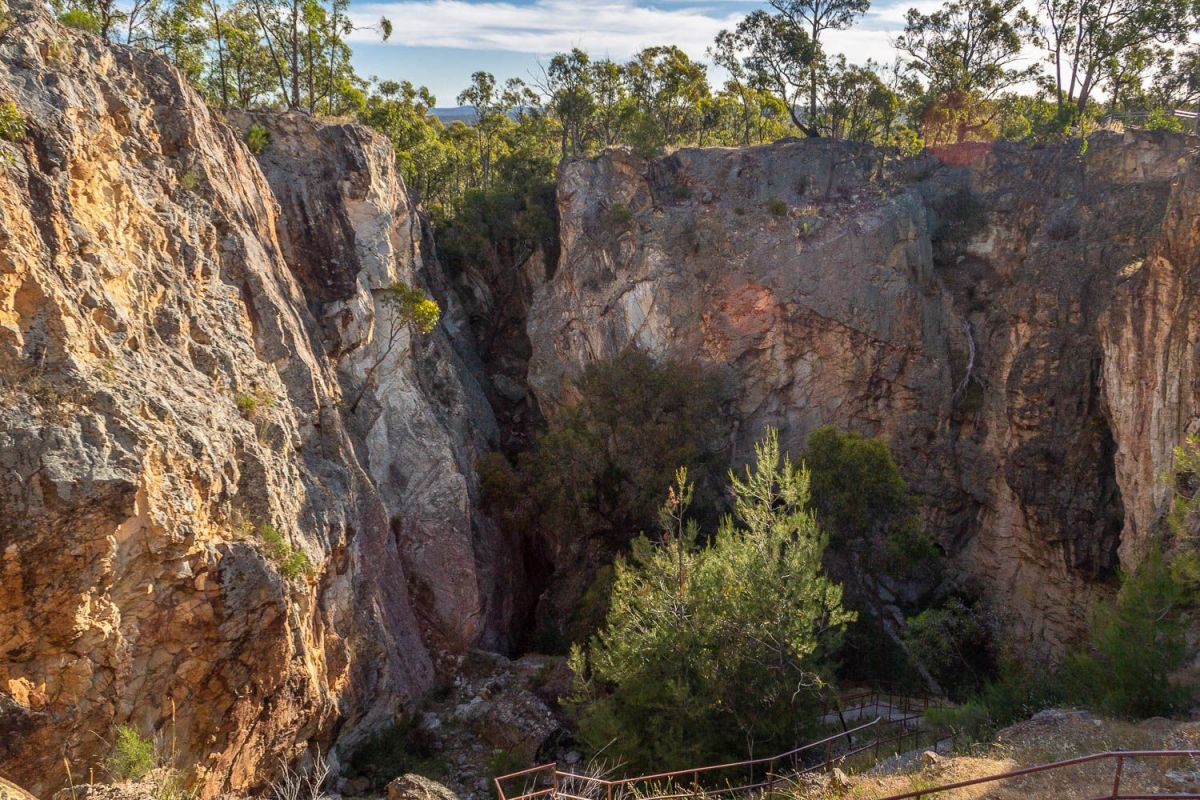Visit the impressive Balaclava Mine at Whroo and look down from the edge into this massive open cut mine!
Lookout points provide views down over the extensive workings below.
John Lewis and James Nickinson discovered a gold nugget on top of this hill on the 25th of October, 1854.
This was the same day as the Battle of Balaklava in Russia, which is where the name Balaclava came from for the mine.
The Balaclava Mine was opened the next year in 1855, and it became the most extensive, famous and rich mine in the north eastern district!

Today visitors can explore the mine via a series of walking tracks and lookout points.
Please note that access to the open cut is now prohibited for safety reasons.
How to get to the Balaclava Mine
The Balaclava Mine is located alongside Reedy Lake Road in Whroo.
From Rushworth, head towards Whroo on the Rushworth-Nagambie Road for about 7km.
Turn left onto Reedy Lake Road, then the Balaclava Mine will be on your right.
It is indicated by signs.
Camping near the Balacalva Mine
Set up camp just down the road from the Balaclava Mine at the free
Greens Campground.
Spend a weekend exploring the many historic sites and walking tracks throughout the Whroo Historic Area!
Some have fire pits with barbecue plates.
Drop toilets are located in the back/centre of the campground.
History of the Balaclava Mine

A Parks Victoria display board at the lookout provides the following information:
John Thomas Lewis and James Nickinson, both sea-men, discovered a large nugget of gold in the grass on top of the highest hill at Whroo on 25 October 1854.
This was the same date as the Battle of Balaklava in Russia during the Crimean War. Hence the Balaclava Mine derived its name from the English spelling.
In May 1855, the Balaclava Mine was opened.
In July 1863 Lewis drove a tunnel from west to east through Balaclava Hill, to allow a tramline to operate.
Gold bearing quartz was carted out of the mine on the tramline to nearby steam driven stamping batteries where it was crushed to release the gold.
Archibald Menzies used wealth gained from his Balaclava Mine venture with John Lewis, to build the majestic Menzies Hotel that was situated on the corner of Bourke and William Streets in Melbourne.
Lewis and Menzies crushed 85,804 tons of quartz and recovered 21,340 ounces of gold worth 85,000 pounds sterling from 1866 to 1881.
Balaclava Mine - Whroo Historic Reserve
"A century has passed and the Balaclava Hill remains in fact as well as in name, while the miners, their machinery, and their buildings have gone but in the hill the great open cut gapes like a crater, and from the bottom of the crater one can still enter the horizontal tunnel cut for the tramway for a hundred metres or so ..." From Don John of Balaclava by Miles Lewis 1977
John Thomas Lewis and James Meek Nickinson, both sailors, discovered a large nugget of gold in the grass on top of the highest hill at Whroo on 25 October 1854.
This was the same date as the Battle of Balaklava in Russia during the Crimean War, hence the name Balaclava Mine.
It was the most famous, extensive and richest mine in the north eastern district with 15cm gold veins crisscrossing through the quartz, producing over £1,000,00 [sic] worth of gold.
The mine was first developed using shafts to follow the rich veins of auriferous (gold bearing) quartz. The main shaft was sunk to a depth of over 400 feet (122 metres), with levels opened at various depths.
In 1863 Lewis hired some men to drive a tunnel from west to east through Balaclava Hill to build a tramline.
Gold bearing quartz was carried along the tramline to nearby steam driven stamping batteries where the hard rock was crushed to a fine powder to release the gold.
The remains of this process are piles of fine grey sand called 'mullock heaps'.
To try to save money, the company blew up the mine workings with a large charge of dynamite.
They hoped this would enable them to quarry the mine, but the blast only made it unsafe to continue shaft mining.
However, a convenient opening was made in the side of the hill and the hole body of the hill was conveyed by tramway to the nearby steam-driven stampers.
Mining was frequently hampered by a shortage of water. Between March 1865 and April 1866, work stopped for 6 months due to lack of water.
Then rain fell so heavily that all the races leading to a partially built dam were broken and only enough water for two months were collected.
The dam was finally completed and by August it was full of water, with only an exceptionally dry season stopping work again.
The mine was worked on and off for many years depending on investors.
Dick Bell and his father were the last people mining at Balaclava Hill, with their shaft being filled in by the Mines Department's shaft filling dozer in the 1960s.
Safety
Mining sites are very interesting, but they can also be dangerous. Cave-ins or falling rock are unpredictable. Please keep to the tracks for your safety and enjoyment of the area.
More useful information



